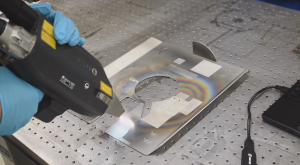Although specific benefits vary by process, PVD coatings are growing more popular in aerospace, military, automotive, energy, food processing, and other large manufacturing industries where there is a big emphasis on durability and longevity. With heat-resistant and friction reducing capabilities, PVD coatings are ideal for high-end products, decorative finishes, semi-conductors, and medical devices.
WHAT IS PHYSICAL VAPOR DEPOSITION?
Physical vapor deposition, or PVD, is a coating process in which a solid material is vaporized in a vacuum and deposited onto the surface of a part. The material is deposited atom by atom, in an “atomic painting” of sorts, forming a thin, bonded metal surface layer. This layer is extremely resistant and can improve appearance, durability, and/or overall function making it ideal for a wide variety of parts and products.
COMMON PVD COATINGS INCLUDE:
- Titanium, Zirconium, Aluminum, Stainless Steel, Copper, and Gold
WHY USE A PVD COATING?
 One reason companies use PVD processes is because it allows them to manufacture products using less expensive coating alternatives, like titanium nitride (TiN). Titanium nitride—commonly found on household fixtures, knives, and scissors—is an extremely hard ceramic coating material that is similar in appearance to gold but comes at a much cheaper price point. By using TiN instead of gold, manufacturers can drastically cut costs while still benefiting from TiN’s superior toughness and aesthetically-pleasing look.
One reason companies use PVD processes is because it allows them to manufacture products using less expensive coating alternatives, like titanium nitride (TiN). Titanium nitride—commonly found on household fixtures, knives, and scissors—is an extremely hard ceramic coating material that is similar in appearance to gold but comes at a much cheaper price point. By using TiN instead of gold, manufacturers can drastically cut costs while still benefiting from TiN’s superior toughness and aesthetically-pleasing look.
Manufacturers using other coating processes have also started to look into PVD methods due to the growing amount of toxic substances that have to be contained, managed, and disposed of. These other “wet” processes use fluid precursors and chemical reactions to achieve the same result as PVD coating processes, but it comes at a cost to the environment.
WHY REMOVE PVD?
Because PVD coatings are applied at an atomic level, trying to remove them without impacting the base material is a difficult task. Reasons for removing PVD coatings may include:
- To release the different stresses that have built up in the layers—they can crack and release particles into the clean-room environment.
- To release the charges that have built up between the layers— the electricity can be fatal if touched.
- For preferential removal—removing certain layers that are more expensive and reworking the inexpensive layers.
 WHY USE LASER ABLATION TO REMOVE PVD?
WHY USE LASER ABLATION TO REMOVE PVD?
The most common method for removing PVD coatings in the past has been media blasting using either sand or dry ice. This aggressive way of knocking off the material is effective but only to a point, as it causes damage to the substrate.
Compared to media blasting techniques, laser ablation comes with a host of advantages including the ability to remove PVD coatings without impacting the base material. Because our laser cleaning systems require no consumables and no labor intensive cleanup, downtime between cleaning is practically non-existent— allowing manufacturers to speed up overall production times.
HOW CAN ADAPT LASER HELP?
The best way to determine if laser ablation will remove PVD coatings from your product is to send a sampling in to our on-site applications lab for testing. Once here, our applications engineers can run testing to help identify if a laser cleaning system is right for you— and which one matches your application needs.
Can’t make it to our Kansas City office in person? Contact us for a virtual lab demonstration led by one of our applications engineers and accompanied by our sales staff. We also have the means to send one of our laser cleaning systems and a sales team member to your on-site location for a safety demonstration and testing on your facility’s specific materials.
Like us on Facebook, connect with us on LinkedIn, and subscribe to us on YouTube.

